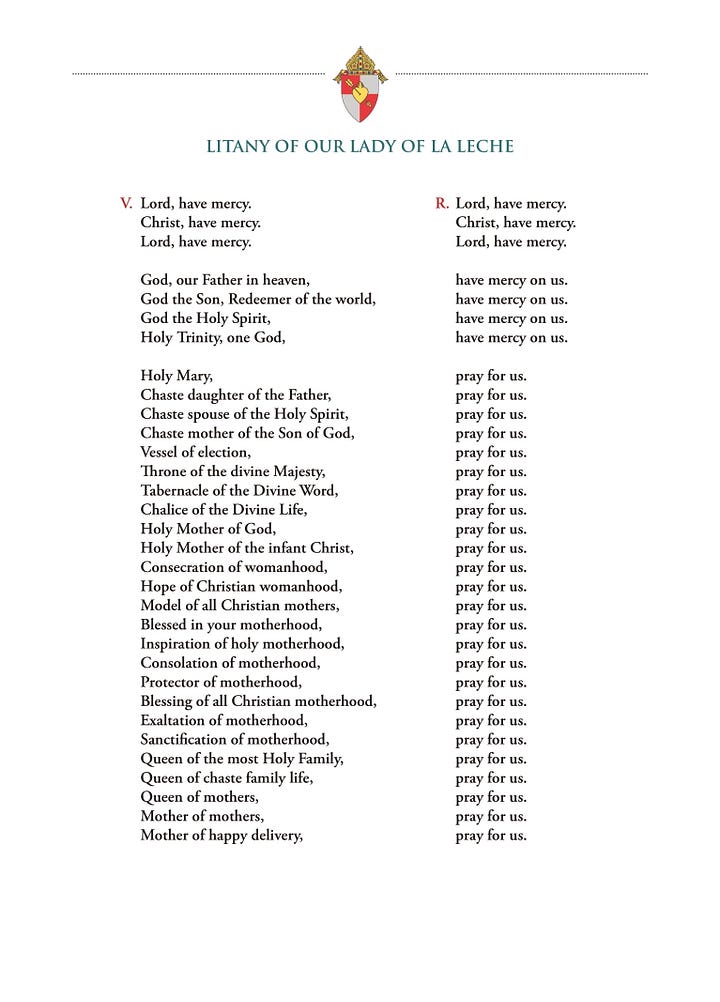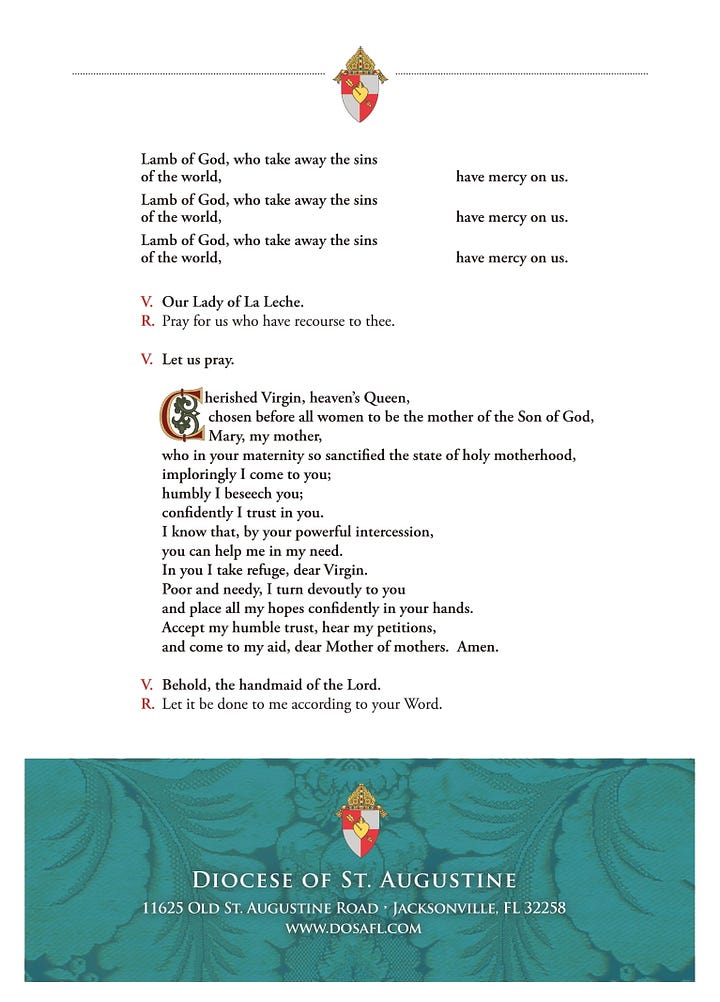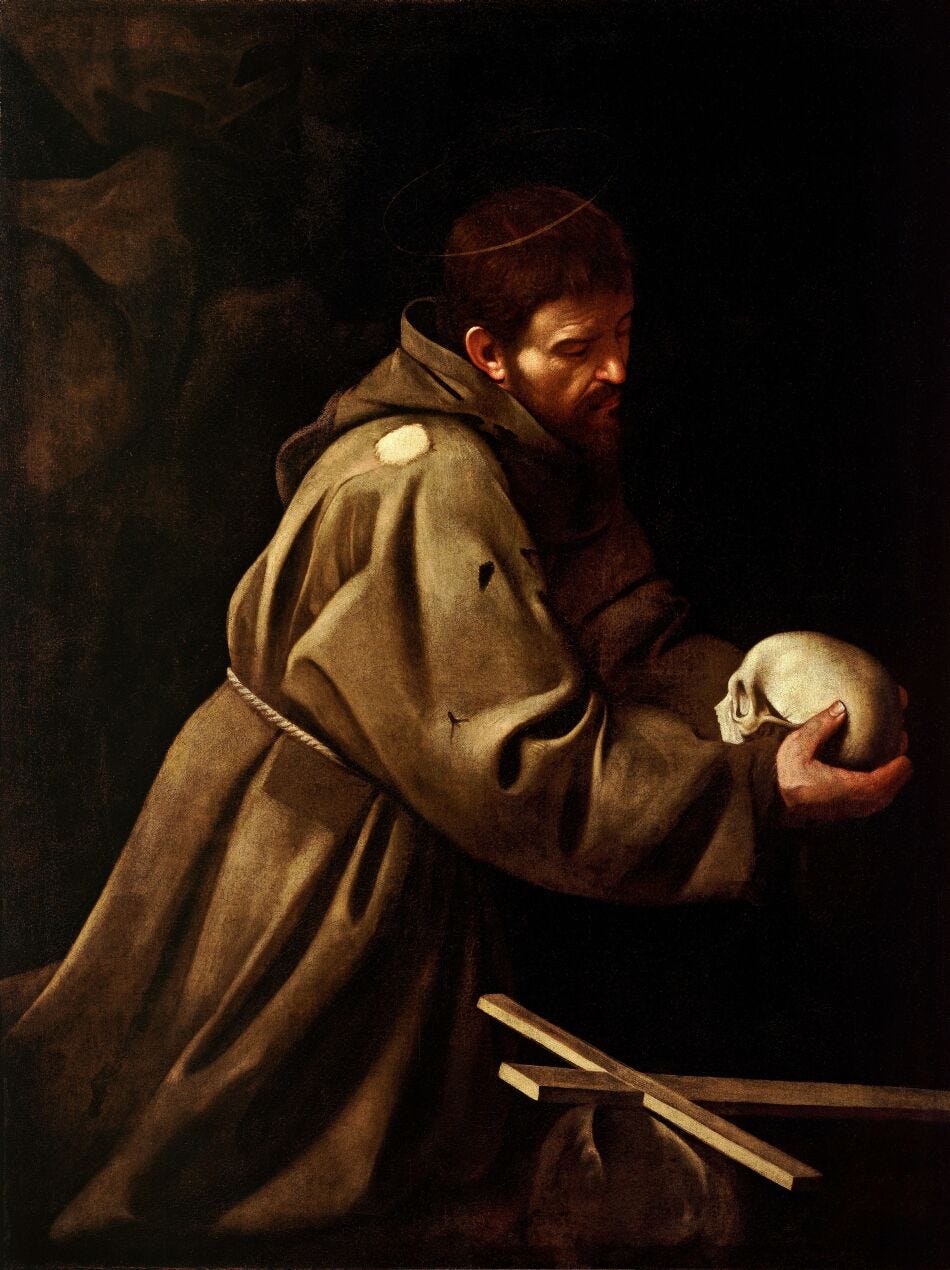Day 3 of the Novena to Our Lady of La Leche, Patroness of Florida
Plus a Blessed Feast of St Francis of Assisi...
Please join us in praying for the defeat of Amendment 4 in Florida and for the consecration of Florida to the Sacred Heart of Jesus and Immaculate Heart of Mary.
Lovely Lady of la Leche, most loving Mother of Jesus, and my mother, listen to my humble prayer. Your motherly heart knows my every wish, my every need. To you only, his spotless Virgin Mother, has your Divine Son given to understand the sentiments which fill my soul. Yours was the sacred privilege of being the Mother of the Savior. Intercede before him now, my loving mother, that in accordance with his will (mention your request here). This I ask, O Lady of La Leche, in the name of your Divine Son, my Lord and Savior. Amen.
V. O Mary, conceived without sin.
R. Pray for us who have recourse to you.
Our Lady of La Leche, pray for us.


For is not Mary the Mother of Christ? Then she is our Mother also. And we must in truth hold that Christ, the Word made Flesh, is also the Savior of mankind. He had a physical body like that of any other man: and again as Savior of the human family, he had a spiritual and mystical body, the society, namely, of those who believe in Christ. "We are many, but one sole body in Christ" (Rom. xii., 5). Now the Blessed Virgin did not conceive the Eternal Son of God merely in order that He might be made man taking His human nature from her, but also in order that by means of the nature assumed from her He might be the Redeemer of men. For which reason the Angel said to the Shepherds: "To-day there is born to you a Savior who is Christ the Lord" (Luke ii., 11). Wherefore in the same holy bosom of his most chaste Mother Christ took to Himself flesh, and united to Himself the spiritual body formed by those who were to believe in Him. Hence Mary, carrying the Savior within her, may be said to have also carried all those whose life was contained in the life of the Savior. Therefore all we who are united to Christ, and as the Apostle says are members of His body, of His flesh, and of His bones (Ephes. v., 30), have issued from the womb of Mary like a body united to its head. Hence, though in a spiritual and mystical fashion, we are all children of Mary, and she is Mother of us all. Mother, spiritually indeed, but truly Mother of the members of Christ, who are we (S. Aug. L. de S. Virginitate, c. 6).
Pope St. Pius X, Ad Diem Illum Laetissimum

His reception of the stigmata happed at Mt. Penna, in La Verna, Tuscany, on September 17, during "St. Michael's Lent" -- a period of fasting which St. Francis voluntarily kept as a personal discipline, and which some Catholics still emulate, from the Feast of the Assumption (August 15) to the Feast of St. Michael the Archangel (September 29).
But at around this time, too, his body -- which he humorously referred to as "Brother Ass" -- began to betray him. Tubercolosis, dropsy, eyesight failing almost to the point of blindness, he knew his time was upon him. He went to the Chapel of San Damiano to vist St. Clare, and there, living in a little hut in the garden of the convent, wrote his "Canticle of the Sun." He then moved on to Assisi, to die in his beloved Porziuncola, surrounded by his brothers -- including a woman he deemed a brother, the Lady Jacoba whom he referred to as "Brother Jacoba." On Ocotber 3, 1226, they read to him the account of Christ's Passion from the Book of St. John, and then he recited Psalm 141. After praying the last verse, after having prayed, "Bring my soul out of prison," he died. The Catholic Encyclopedia tells us what happened next:
...his body was, on 4 October, borne in triumphant procession to the city, a halt being made at St. Damian's, that St. Clare and her companions might venerate the sacred stigmata now visible to all, and it was placed provisionally in the church of St. George (now within the enclosure of the monastery of St. Clare), where the saint had learned to read and had first preached. Many miracles are recorded to have taken place at his tomb. Francis was canonized at St. George's by Gregory IX, 16 July, 1228.
The Portiuncula Indulgence (The Pardon of Assisi)
The day after St. Francis was canonized, Pope Gregory IX started building a great church around the little portiuncula chapel and the cell in which St. Francis died. Pope Pius V, leaving the chapel and cell intact, tore down Pope Gregory's structure and built in its place a larger church -- the Basilica of Santa Maria degli Angeli (Our Lady of the Angels) -- which still stands today. The little chapel inside, which is only 13 and a half feet wide and 22 feet long, became the place where one could receive the Portiuncula Indulgence (also called "the Pardon of Assisi), an indulgence which came about when St. Francis was praying in his chapel, "O God, although I am a great sinner, I beseech You to grant a full pardon of all sins to all who, having repented and confessed their sins, shall visit this church." and was answered wit the words, "Francis, you ask much, but you are worthy of greater things, and greater things you shall have." Pope Honorius III ratified it, letting it be known that anyone who, with a contrite heart, visited the chapel between noon of August 1 and midnight of August 2 could receive a plenary indulgence applicable to themselves or to souls in Purgatory.
This indulgence has been expanded many, many times throughout the centuries, and is now structured such that, between noon on August 1 and midnight of August 2, the faithful may receive a plenary indulgence, under the usual conditions, by 1) wanting to receive the indulgence, 2) visiting any parish church (though a Franciscan church is traditional, and the Portiuncula itself is the most traditional), 3) praying one Our Father, one Apostle's Creed, and one other prayer of the individual's choice, 4) praying for the Pope's intentions, 5) while being free from all sin (including venial sin), and 6) going to Confession and receiving the Eucharist within a week before or after.
Note that if you're ever able to visit the Portiuncula and go to its rose garden, you'll find a very interesting sort of rose. There, a type of dog rose3 grows, but this cultivar (Rosa canina Assisiensis) has lost its thorns. This loss is said to have come about when St. Francis, in the spirit of mortification, threw himself naked into the rose bushes to subdue his flesh. God, not wanting him harmed, stripped the roses of their thorns then and there, and they've been growing that way ever since. Numerous sources say that the Portiuncula's rose garden is the only place in which these thornless dog roses grow.
St. Francis is (along with St. Catherine of Siena) the patron of Italy, and the patron of ecology and of animals.
Customs
Some may prepare for this feast by praying a Novena to St. Francis starting on September 25 and ending on the eve of his feast (October 3). For his feast itself, there is the Litany of the Seraphic Father Saint Francis.
As to foods, a sweet raisin bread is eaten in Italy on this day. A recipe:
Pagnotta dolce di San Francesco
4 (1/4 ounce) packages yeast
1 cup lukewarm water
1 teaspoon sugar
7 cups flour
1 1/2 cups raisins, soaked in water for 30 minutes, drained and patted dry
4 tablespoons olive oil
6 large eggs, room temperature
1 1/2 cups sugar
1 ounce anise flavoring (optional)
Zest of 1 lemon
Zest of 1 orange
1 dash salt
In a large bowl, dissolve yeast and sugar in lukewarm water. Separately, beat together the eggs and sugar. When yeast has foamed after 5 or 10 minutes, add the egg mixture to the yeast mixture. Add the anise, grated rinds, and salt.
In a big bowl, mix flour and raisins. Add yeast mixture to flour, mixing and blending to form a dough. Rub olive oil over dough and set covered in a warm place to rise. In about 2 hours, oil your hands, punch dough down the dough, and let rise again. After the second rise, divide dough into four pieces. Shape into loaved and place into 4 oiled bread loaf pans. Let rise to double in bulk. Bake at 350oF degrees 10 minutes. Loosely cover pans with foil, reduce heat to 300oF degrees and bake 20 minutes longer.
Catholics who live in Mexico or the Southwestern part of the United States might consider making a pilgrimage to the Nuestra Señora de la Purisima Concepcion church in the town of Real de Catorce, in the Mexican state of San Luis Potosí. Around the feast of St. Francis, pilgrimage is made there to ask for -- or in gratitude for -- miraclulous healings and other favors. The hundreds of a sort of ex-voto called retablos that can be seen in the church are testament to God's doings in response to prayer made there. While there in the days honoring St. Francis, there are religious processions, music, dancing, etc.
The stories concerning St. Francis were collected and put together by Brother Ugolino in the early 14th century, roughly seventy years after St. Francis died. The collection is referred to as "The Little Flowers of Saint Francis" (I Fioretti), and contains the stories of St. Francis preaching to the birds (Chapter XVI), his interaction with the wolf at Gubbio (Chapter XXI), his taming the doves (Chapter XXII), etc. I present them here: The Little Flowers of Saint Francis of Assisi.





